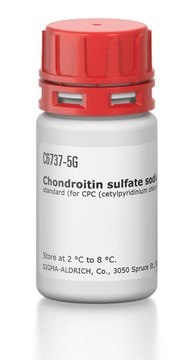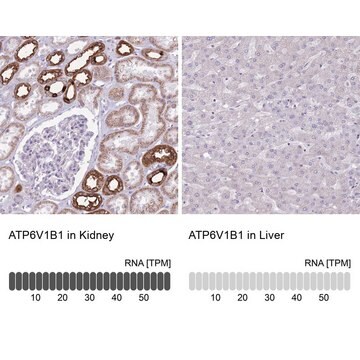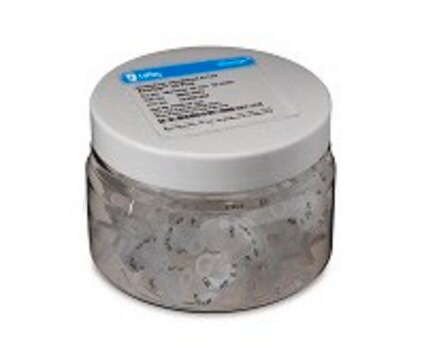推荐产品
生物源
rabbit
品質等級
共軛
unconjugated
抗體表格
IgG fraction of antiserum
抗體產品種類
primary antibodies
無性繁殖
polyclonal
形狀
lyophilized powder
物種活性
rat, human
技術
immunohistochemistry: suitable
western blot (chemiluminescent): 1:200-1:1000
UniProt登錄號
儲存溫度
−20°C
目標翻譯後修改
unmodified
基因資訊
human ... AQP2(359)
mouse ... Aqp2(11827)
rat ... Aqp2(25386)
一般說明
水通道蛋白2(AQP2)以四聚体的形式存在,其C末端可具有多种构象并结合了两个镉离子。AQP2基因定位于人染色体12q13.12。它与细胞内囊泡有关。
水通道蛋白2(AQP2)是一种用于调节肾连合小管和集尿管中水平衡的水通道蛋白。AQP2由抗利尿激素激活,然后促进水分流入肾细胞。该蛋白还与整合素相互作用,以调节上皮细胞形态和细胞运动。抗水通道蛋白2抗体通过免疫印迹法识别大鼠中的水通道蛋白2。该抗体也与小鼠和人的AQP2发生反应。
免疫原
对应于大鼠或小鼠水孔蛋白2(具有额外的N端赖氨酸和酪氨酸)的氨基酸254-271的合成肽通过戊二醛与KLH偶联。该表位在大鼠和小鼠中相同,在人类中高度保守。
應用
使用浓度为5μg/ml的兔抗AQP2对10%福尔马林固定、石蜡包埋的大鼠肾脏切片进行免疫组织化学检测。使用抗AQP2可以观察到髓质粗大的升肢和集合管。
抗-水通道蛋白2兔抗可用于:
- 免疫染色
- 免疫组织化学
- 免疫荧光
- 免疫印迹
抗水通道水孔蛋白2抗体也适用于化学发光蛋白印迹(1:200-1:1000)和免疫印迹。
生化/生理作用
水通道蛋白(AQP2)N末端区域在运输中起着关键作用。C端磷酸化对根尖膜的透水功能至关重要。此外,在第270位赖氨酸的泛素化对于AQP2实现在溶酶体中的分类和降解,或通过外泌体实现消除是必需的。AQP2基因突变与先天性肾源性尿崩症(NDI)这种水平衡紊乱有关。AQP2的功能失调与先兆子痫、充血性心力衰竭以及肝硬化有关。
外觀
从含有磷酸盐缓冲液(pH 7.4)、1%BSA和0.05%叠氮化钠的溶液中冻干。
準備報告
分离于固定化蛋白A
免責聲明
除非我们的产品目录或产品附带的其他公司文档另有说明,否则我们的产品仅供研究使用,不得用于任何其他目的,包括但不限于未经授权的商业用途、体外诊断用途、离体或体内治疗用途或任何类型的消费或应用于人类或动物。
未找到合适的产品?
试试我们的产品选型工具.
訊號詞
Danger
危險分類
Acute Tox. 3 Dermal - Acute Tox. 4 Inhalation - Acute Tox. 4 Oral - Aquatic Chronic 3
儲存類別代碼
6.1C - Combustible acute toxic Cat.3 / toxic compounds or compounds which causing chronic effects
水污染物質分類(WGK)
WGK 3
閃點(°F)
Not applicable
閃點(°C)
Not applicable
個人防護裝備
Eyeshields, Gloves, type N95 (US)
Khalil El Karoui et al.
Nature communications, 7, 10330-10330 (2016-01-21)
In chronic kidney disease (CKD), proteinuria results in severe tubulointerstitial lesions, which ultimately lead to end-stage renal disease. Here we identify 4-phenylbutyric acid (PBA), a chemical chaperone already used in humans, as a novel therapeutic strategy capable to counteract the
George J Schwartz et al.
The Journal of clinical investigation, 125(12), 4365-4374 (2015-11-01)
The nephron cortical collecting duct (CCD) is composed of principal cells, which mediate Na, K, and water transport, and intercalated cells (ICs), which are specialized for acid-base transport. There are two canonical IC forms: acid-secreting α-ICs and HCO3-secreting β-ICs. Chronic
Alexandra Rieger et al.
PloS one, 11(7), e0158977-e0158977 (2016-07-16)
During nephrogenesis, POU domain class 3 transcription factor 3 (POU3F3 aka BRN1) is critically involved in development of distinct nephron segments, including the thick ascending limb of the loop of Henle (TAL). Deficiency of POU3F3 in knock-out mice leads to
Kuniaki Takata et al.
Histochemistry and cell biology, 130(2), 197-209 (2008-06-21)
Aquaporins (AQPs) are membrane proteins serving in the transfer of water and small solutes across cellular membranes. AQPs play a variety of roles in the body such as urine formation, prevention from dehydration in covering epithelia, water handling in the
Jared Q Gerlach et al.
PloS one, 8(9), e74801-e74801 (2013-09-27)
Urinary extracellular vesicles (uEVs) are released by cells throughout the nephron and contain biomolecules from their cells of origin. Although uEV-associated proteins and RNA have been studied in detail, little information exists regarding uEV glycosylation characteristics. Surface glycosylation profiling by
我们的科学家团队拥有各种研究领域经验,包括生命科学、材料科学、化学合成、色谱、分析及许多其他领域.
联系技术服务部门








